Chinese scientists find that NMN protects against intestinal damage caused by radiation — commonly used to treat elderly cancer patients.
By Victor Ciardha 2022. Original Article: www.nmn.com
Highlights:
Radiotherapy is commonly used to treat elderly cancer patients who are often too frail to undergo surgery or receive chemotherapy. However, 60 to 80% of patients who receive radiotherapy for abdominal and pelvic tumors suffer from intestinal injury. Furthermore, there is currently no option available to rescue radiation-induced intestinal damage.
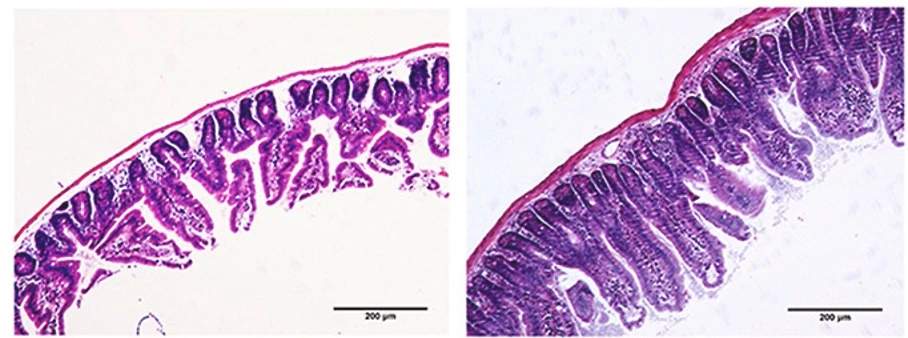
Radiation exposed intestinal wall tissue before (left) and after (right) NMN treatment.
Now, researchers from the Chinese Academy of Medical Sciences and Peking Union Medical College report in Free Radical Biology and Medicine that NMN ameliorates radiation-induced damage in mice. In mouse intestinal cells deficient in a protein called NRF2, Zhao and colleagues show that NMN reduces DNA damage and decreases ROS invoked by radiation. Treatment with NMN also protects against radiation-induced intestinal injury in mice deficient in NRF2. The promising effects of NMN were mediated by increases in sirtuin enzymes.
NMN Protects the Intestinal Wall from Radiation
Radiation kills cancer cells by producing ROS and inducing DNA damage, but it can also cause damage to surrounding cells. The NRF2 protein plays an important role in reducing ROS and DNA damage but decreases with aging. Thus, NRF2 deficiency makes elderly individuals more susceptible to radiation-induced damage. For this reason, Zhao and colleagues experimented with NRF2-deficient cells to model what occurs with aging.
Not only did NRF2-deficient intestinal cells exposed to radiation display increased levels of ROS, DNA damage, and cell death, but they also had more senescent cells — cells that progress the aging process when not eliminated. These findings suggest that radiation may trigger senescence in cancer patients. Moreover, NMN treatment reduced ROS, DNA damage, and cell death. These findings suggest that NMN can help compensate for NRF2 deficiency in intestinal cells challenged with radiation.
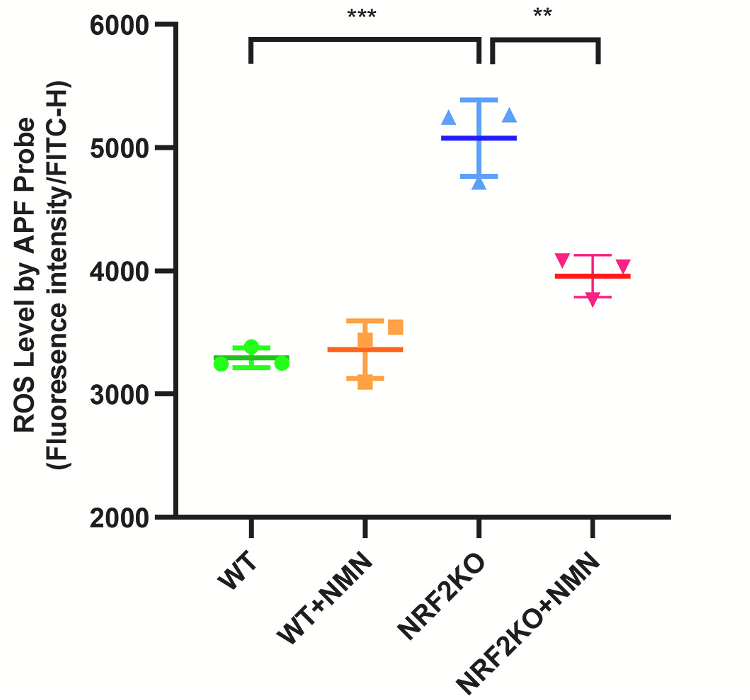
Zhao et al., 2022 | Radic. Biol. Med.)
NMN Reduces Reactive Oxygen Species (ROS). When the NRF2 protein is genetically removed from mouse intestinal cells (NRF2KO), ROS levels are increased. However, treating these cells with NMN (NRF2KO+NMN) reduces ROS levels.
Sirtuins are enzymes that use NAD+ to fuel cell survival activity. Zhao and colleagues showed that NMN increased sirtuin protein levels, suggesting NMN’s effects are mediated by sirtuins. They then tested whether NMN and sirtuins protect against radiation-induced intestinal damage by feeding NRF2-deficient mice 300 mg/kg/day of NMN. The mice were then exposed to abdominal radiation.
Intestinal damage was measured by assessing several features of the intestinal wall, including villi length. Villi are outgrowths of the intestinal wall that help to increase the surface area of the intestine for nutrient absorption. While radiation exposure led to decreased villi length in untreated NRF2-deficient mice, when these mice were treated with NMN, villi length was restored. These findings show that NMN protects against radiation-induced intestinal damage in cases of low NRF2.

Zhao et al., 2022 | Radic. Biol. Med.)
NMN Protects Against Radiation-Induced Intestinal Damage. Compared to untreated NRF2-deficient mice (CTRL), NRF2-deficient mice exposed to ionizing radiation (NRF2KO-IR) have short villi. However, treating these mice with NMN (NRF2KO-NMN + IR) restores villi length.
Previous studies have shown that NMN promotes the function of sirtuin 1 (SIRT1). However, there exists a family of seven sirtuins, and in this study, NMN increased sirtuin 6 (SIRT6) and sirtuin 7 (SIRT7). These sirtuins seem to have antioxidant properties, as they mediate the reduction in ROS — oxidants that can cause damage to cells. Sirtuins also mediate DNA repair processes.
“Our results reveal the function of SIRT6 and SIRT7 independent of NRF2 and implicate the sophisticated network of sirtuin family [members] as regulators of different physiological or pathological states,” say the authors.
NMN Reduces Cancer Treatment Side Effects and Enhances Efficacy
Cancer treatments are far from perfect and come with long-term side effects. However, some of these side effects are prevented by NMN. For example, NMN combined with troxerutin was shown to fully protect the heart from damage caused by the chemotherapy drug doxorubicin. Now, Zhao and colleagues show that NMN can alleviate the long-term side effects of radiation therapy.
“NMN could be a promising supplement to alleviate radiation-induced intestinal injury,” state the authors.
NMN also enhances the effects of immunotherapies, the latest innovation in cancer therapy that utilizes immune cells to suppress tumor progression. For example, NMN was shown to enhance natural killer cell immunotherapy against skin and liver cancer and boosts CAR-T cell immunotherapy against blood cancer. Furthermore, the NAD+ precursor NR has also been shown to enhance immunotherapies and NRH prevents tumor regrowth after brain cancer surgery. Thus, boosting NAD+ with its precursors holds promise in conjunction with traditional cancer treatments.
Story Source
Zhao X, Zhang M, Wang J, Ji K, Wang Y, Sun X, Xu C, Wang Q, He N, Song H, Du L, Wang F, Huang H, Liu Y, Liu Q. NMN ameliorated radiation-induced damage in NRF2-deficient cell and mice via regulating SIRT6 and SIRT7. Free Radic Biol Med. 2022 Oct 14:S0891-5849(22)00897-8. doi: 10.1016/j.freeradbiomed.2022.10.267. Epub ahead of print. PMID: 36252808.
Italian scientists find that the anti-aging compound resveratrol mitigates markers of aging, including abnormal heart rhythms and senescent cells in a human heart model.
By Victor Ciardha www.nmn.com
Highlights:
Partakers of wine have postulated that their drinking habits could benefit their health, as wine contains resveratrol, a powerful antioxidant associated with cardiovascular protection and slowing aging. While resveratrol comes naturally in other foods like peanuts and blueberries, the hope is that chronic consumption of red wine could be enough to take advantage of resveratrol.
In Theranostics, Lazzarini and colleagues from the Istituto Cardiocentro Ticino and the University of Milano-Bicocca in Italy report that resveratrol can mitigate aging in a human cardiac muscle cell model. By inducing senescence in cardiac muscle cells (CMs), the researchers recapitulate signs of aging such as abnormal heart rhythms and senescent cell buildup. They then show that resveratrol treatment mitigates these features of aging.
Resveratrol Reverses Signs of Cardiac Aging
Aging is associated with an increased incidence of abnormal heart rhythms (cardiac arrhythmias) and heart failure. To examine the effect of resveratrol on the aged heart, Lazzarini and colleagues generated a model for aged — senescent — CMs (SenCMs) and treated them with resveratrol. They then measured the electrical signal generated by clusters of CMs to look for heart rhythm abnormalities. They found that resveratrol partially restored abnormal heart rhythms in SenCMs, suggesting that resveratrol could mitigate age-related cardiac tissue dysfunction.
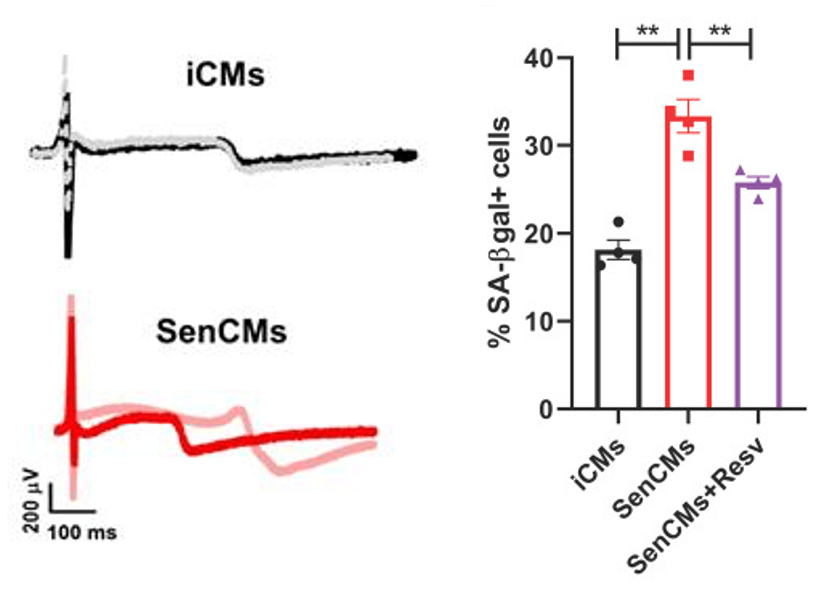
(Lazzarini et al., 2022 | Theranostics) Resveratrol Reduces Signs of Aging. Compared to unstressed CMs (iCMs), aged CMs (SenCMs) have abnormal heart rhythms (left). Resveratrol reduces the percentage of senescent cells (SA-β gal) amongst aged cells (SenCMs + Resv).
The processes underlying the abnormal heart rhythms associated with aging remain unclear, but the accumulation of senescent cells may play a role. Cells typically go into a senescent (growth-arrested, non-proliferating) state in response to cellular stress to stop cancer progression. However, as they accumulate with age, senescent cells can become harmful by promoting inflammation and damaging tissue. One of the only ways to get rid of senescent cells is with senoltyics — drugs that eliminate senescent cells.
Lazzarini and colleagues harnessed chemical stress (doxorubicin) to force some CMs into a senescent state. These SenCMs exhibited signs of aging, such as the abnormal heart rhythms shown above, thus recapitulating aspects of aged CMs. The Italian scientists then demonstrated that senescent cells could be reduced by resveratrol. These findings suggest that resveratrol could act as a senolytic. Also, this reduction in senescent cells potentially contributes to restoring the abnormal heart rhythms exhibited by the SenCMs.
Can Resveratrol Protect Our Heart?
Since resveratrol is contained in the skin of grapes, some have wondered if drinking wine could protect the heart from dysfunction. However, a study of nearly 80,000 Swedish individuals 45 to 83 years of age showed that drinking over 14 glasses of wine a week leads to an increased risk of atrial fibrillation, a deadly heart condition. Overall, the effect of wine on the heart is unclear. Still, many studies point to resveratrol improving the cardiac dysfunction associated with aging. However, a dose of about 1 gram per day is thought to be necessary to reap the benefits of resveratrol, and it would not be possible to consume enough wine to achieve this dose. Therefore, if resveratrol could really protect the heart against aging, it would have to be consumed through diet or supplementation.
Story Source
Lazzarini E, Lodrini AM, Arici M, Bolis S, Vagni S, Panella S, Rendon-Angel A, Saibene M, Metallo A, Torre T, Vassalli G, Ameri P, Altomare C, Rocchetti M, Barile L. Stress-induced premature senescence is associated with a prolonged QT interval and recapitulates features of cardiac aging. Theranostics. 2022 Jul 4;12(11):5237-5257. doi: 10.7150/thno.70884. PMID: 35836799; PMCID: PMC9274748.
Journal Reference
Mirza M, Strunets A, Shen WK, Jahangir A. Mechanisms of arrhythmias and conduction disorders in older adults. Clin Geriatr Med. 2012 Nov;28(4):555-73. doi: 10.1016/j.cger.2012.08.005. PMID: 23101571; PMCID: PMC3610528.
Larsson SC, Drca N, Wolk A. Alcohol consumption and risk of atrial fibrillation: a prospective study and dose-response meta-analysis. J Am Coll Cardiol. 2014 Jul 22;64(3):281-9. doi: 10.1016/j.jacc.2014.03.048. PMID: 25034065.
Weiskirchen S, Weiskirchen R. Resveratrol: How Much Wine Do You Have to Drink to Stay Healthy? Adv Nutr. 2016 Jul 15;7(4):706-18. doi: 10.3945/an.115.011627. PMID: 27422505; PMCID: PMC4942868.
Chinese scientists find that boosting NAD+ with its precursor, NMN improves the learning and memory of a mouse model for Alzheimer’s disease.
By Victor Ciardha
Highlights:
While the accumulation of a protein called beta-amyloid (Aβ) is undoubtedly involved, the underlying cause of AD is still a mystery. And as the search for a cure continues, a new study published in Biological Research has shown that NAD+, an essential molecule needed to produce the energy of all cells, may play a key role.
In the study, Hu and colleagues from the Shanghai Geriatric Institute of Chinese Medicine reveal that boosting NAD+ reverses AD defects in a mouse model for AD. The researchers treated AD mice with either NMN, an NAD+ precursor that promotes the synthesis of NAD+, or a CD38 inhibitor (antibody). As an NAD+ degrading enzyme that increases with age, CD38 is considered the primary contributor to age-related NAD+ decline. The results showed that NMN or the CD38 inhibitor improve the learning and memory of AD mice and reduces inflammation, a hallmark of aging. Furthermore, boosting NAD+ decreases the prevalence of Aβ.
Boosting NAD+ Reverses Alzheimer’s Disease Defects
Demonstrating the cognitive deficits associated with AD, Hu and colleagues showed that AD mice perform worse on learning and memory tests than aged mice without AD. However, the learning and memory of AD mice improved after treatment with NMN or the CD38 inhibitor, suggesting that boosting NAD+ could improve the cognitive deficits associated with AD.

(Hu et al., 2022 | Biological Research) Learning and Memory are Improved by NMN and CD38 Inhibition. Relative to typically aged mice (black – control group), untreated AD mice (red – model group) have reduced learning and memory scores, measured by new object recognition (left) and platform crossings (right). However, AD mice treated with a CD38 inhibitor (pink – CD38 inhibitor group) or NMN (blue – NMN group) show improvements in both measurements compared to untreated AD mice.
Microglia cells are responsible for degrading harmful brain material such as excess Aβ. However, this degrading process (phagocytosis and autophagy) is slow and promotes inflammation. Thus, if microglia cannot keep up with the production of Aβ, inflammation ensues without complete Aβ removal. To exacerbate it all, Aβ can inhibit this critical function of microglia, allowing inflammation to persist, and causing progressive damage to neurons, leading to neuron cell death (neurodegeneration) and cognitive decline.
Maintaining the energy metabolism of microglia is essential for sustaining their Aβ-degrading function. NAD+ supports energy metabolism by facilitating the production of ATP, a molecule that cells use for energy. In aged microglia cells, low NAD+ and ATP make these immune cells less efficient or incapable of degrading Aβ. Thus, boosting NAD+ could increase the production of ATP, reviving the destructive power of microglia.
Hu and colleagues showed that NMN or CD38 inhibition increased the concentration of NAD+ and ATP in the brains of AD mice while reducing inflammation. These findings suggest that boosting NAD+ restores energy metabolism and reduces inflammation in AD mice, which could explain the observed improvements in learning and memory.

(Hu et al., 2022 | Biological Research) Energy Metabolism is Reinvigorated by NMN and CD38 Inhibition. In the hippocampus, the brain region associated with learning and memory, AD mice have lower NAD+ and ATP. Treatment with either CD38 inhibition or NMN increases NAD+ and ATP levels.
Microglia cells take different forms; in their active form, they become harmful and produce inflammatory molecules. Hu and colleagues showed that boosting NAD+ reduces microglial activation and eliminates Aβ from AD mouse brains. These findings suggest that increasing NAD+ levels restores the destructive capacity of microglia cells, enabling them to rid the brain of harmful Aβ deposits.

(Hu et al., 2022 | Biological Research) NMN and CD38 Inhibition Rid the Brain of Aβ. Amyloid plaques, measured with green fluorescent staining (green), were increased in untreated AD mice (model group), but reduced by a CD38 inhibitor (CD38 inhibitor group) or NMN (NMN group).
Can Boosting NAD+ Treat Alzheimer’s?
Overall, the findings of Hu and colleagues suggest that boosting NAD+ by inhibiting CD38 or supplementing with NMN revives aged microglia cells, allowing them to destroy Aβ and reduce inflammation in AD mice. This reduction in inflammation could lead to improvements in learning and memory. Another study showed that genetically removing CD38 can improve the memory of AD mice. Furthermore, boosting NAD+ with another precursor, NR, has been shown to reduce neuroinflammation, possibly leading to improved cognitive performance. Indeed, a recent study showed that reducing inflammation with a molecule called saikogenin F improves the learning and memory of AD mice.
While these animal studies make boosting NAD+ seem like a promising treatment for AD, there are not enough human studies to validate the findings. For example, a recent study showed that while NR and caffeine raise NAD+ and ATP levels in cells cultured from AD patients, it does not improve metabolic parameters. However, it is unclear from this study whether NR and caffeine could improve cognitive performance in AD patients. Thus, the effect of boosting NAD+ on cognitive performance in AD patients still needs to be tested, but the prospects seem promising.
Model and Dosage
Model: aged (30-week-old) APP/PS1 mice
Dosage: 0.093 mg/mL NMN dissolved in water and injected intraperitoneally
Story Source
Hu Y, Huang Y, Xing S, Chen C, Shen D, Chen J. Aβ promotes CD38 expression in senescent microglia in Alzheimer’s disease. Biol Res. 2022 Mar 3;55(1):10. doi: 10.1186/s40659-022-00379-1. PMID: 35241173; PMCID: PMC8892694.
Journal Reference
Blacher E, Dadali T, Bespalko A, Haupenthal VJ, Grimm MO, Hartmann T, Lund FE, Stein R, Levy A. Alzheimer’s disease pathology is attenuated in a CD38-deficient mouse model. Ann Neurol. 2015 Jul;78(1):88-103. doi: 10.1002/ana.24425. Epub 2015 May 25. PMID: 25893674; PMCID: PMC6929692.
Roboon J, Hattori T, Ishii H, Takarada-Iemata M, Nguyen DT, Heer CD, O’Meally D, Brenner C, Yamamoto Y, Okamoto H, Higashida H, Hori O. Inhibition of CD38 and supplementation of nicotinamide riboside ameliorate lipopolysaccharide-induced microglial and astrocytic neuroinflammation by increasing NAD. J Neurochem. 2021 Jul;158(2):311-327. doi: 10.1111/jnc.15367. Epub 2021 May 9. PMID: 33871064; PMCID: PMC8282715.
Chen Z-H, Li J, Zhao X-X, et al. Saikogenin F From Bupleurum smithii Ameliorates Learning and Memory Impairment via Antiinflammation Effect in an Alzheimer’s Disease Mouse Model. Natural Product Communications. July 2022. doi:10.1177/1934578X221111029
Ryu WI, Shen M, Lee Y, Healy RA, Bormann MK, Cohen BM, Sonntag KC. Nicotinamide riboside and caffeine partially restore diminished NAD availability but not altered energy metabolism in Alzheimer’s disease. Aging Cell. 2022 Jun 21:e13658. doi: 10.1111/acel.13658. Epub ahead of print. PMID: 35730144.
A recently-published University of Toyama study from Japan reveals that a daily intake of 250 mg of nicotinamide mononucleotide (NMN) significantly raises blood NAD+.
By Brett J. Weiss www.nmn.com
Highlights
Healthy aging has become a keynote topic as the world’s population grows older and the proportion of elderly individuals becomes larger. Known as the “silver tsunami,” the number of individuals over the age of 60 is expected to double by 2050. Accumulating research from the last 10 years or so suggests that enhancing cell energy production with NAD+ precursors, including NMN and nicotinamide riboside (NR), prevents the waning organ and tissue function associated with aging. Furthermore, scientists are seeking to confirm whether these precursors effectively increase blood concentrations of the essential molecule NAD+.
Published in Frontiers in Nutrition, Nakagawa and colleagues recently demonstrated that in healthy humans between 22 and 64 years old, NMN substantially increased blood NAD+ levels with oral usage of 250 mg per day. Blood NAD+ levels almost doubled and plateaued at approximately four weeks of usage and were sustained for the 12-week duration of the clinical trial. No negative blood measurements pertaining to blood fats, white blood cell counts, or liver function markers were observed after four weeks of NMN supplementation. No adverse effects on body weight or blood pressure were seen, either. What’s more, elevations in heart rate were strongly correlated with increased whole blood NAD+ levels, indicating that a higher heart rate facilitates the metabolism of NAD+, leading to greater NAD+ levels.
“We demonstrated that taking 250 mg of NMN every day for 12 weeks is a safe and well-tolerated practice in healthy individuals,” stated Nakagawa and colleagues in their publication. “These results suggest that the oral administration of NMN is safe and can be a practical strategy to boost NAD+ levels in humans.”
Taking NMN Nearly Doubles Blood NAD+ Levels
Nakagawa and colleagues looked at the NAD+ and NMN levels in whole blood measurements during the 12-week time course of NMN administration. The researchers found that NAD+ levels nearly doubled from over 20 µM to almost 45 µM concentrations in blood after four weeks. These blood NAD+ values plateaued to about week 12 and then expectedly dissipated after four weeks of stopping NMN supplementation. Moreover, the levels of NMN itself in blood showed no differences compared to subjects who did not receive NMN, suggesting that cells almost completely metabolize NMN from the blood. These findings show that 250 mg of NMN is easily metabolized and leads to nearly doubled blood NAD+ levels, which trend toward dissipating after four weeks.
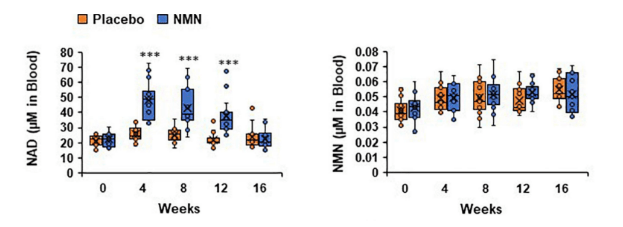
(Okabe et al., 2022 | Frontiers in Nutriton) Supplementing with NMN for 12 weeks stimulates nearly double-fold levels of blood NAD+ without increasing whole blood NMN levels. Beginning at four weeks of taking NMN orally at 250 mg per day, whole blood levels of NMN nearly double and plateau for the remainder of the treatment duration (graph on the left). Blood NMN levels remain unchanged throughout the 12-week supplementation duration and four weeks following NMN dosing cessation (week 16). These results demonstrate that supplementing humans with NMN not only nearly doubles blood NAD+ levels but also that NMN levels do not increase, showing that blood NMN may be substantially metabolized.
NMN Drives No Adverse Side Effects in Humans
NAD+ plays a vital role in thousands of biochemical reactions within cells and maintains energy levels by supporting the generation of the molecule adenosine triphosphate (ATP), the primary energy currency of our cells. In mouse models, increasing NAD+ throughout the body protects against the age-related organ and tissue degeneration associated with diseases like cardiovascular disease, Alzheimer’s disease, and liver disease. To promote proper physiological function, proteins called poly (ADP-ribose) polymerases (PARPs) consume NAD+ to repair damaged DNA. Other proteins called Sirtuins utilize NAD+ to regulate gene function, metabolism, and the body’s stress response. All of these findings regarding NAD+ demonstrate that increasing the cellular abundance of this molecule may hold the key to promoting far healthier aging in humans. However, when it comes to boosting NAD+ in humans, safety becomes a critical factor.
To then test whether taking 250 mg/day doses of NMN drives any adverse side effects, the Japan-based research team examined a few important physiological parameters. Nakagawa and colleagues found that 12-week NMN supplementation had no effect on body weight, showing no weight gain or loss. The research team also found no significant changes in body mass index, a ratio of body weight over physical height used as a measurement of body fat. Also, blood pressure measurements remained stable during supplementation. These data suggest that no adverse physiological side effects could be attributed to taking 250 mg per day of NMN for 12 weeks.

(Okabe et al., 2022 | Frontiers in Nutriton) Oral NMN supplementation with 250 mg per day for 12 weeks causes no significant changes in physiological measurements of body weight or blood pressure. Starting from the left, the graphs show that administering oral NMN causes no changes in body weight (BW), body mass index (BMI), heart pumping pressure (systolic blood pressure), or pressure from the heart filling with blood (diastolic blood pressure). These findings indicate that supplementing with NMN gives no major physiological side effects.
Nakagawa and colleagues sought to find whether pulse rate correlated with an increase in total blood NAD+ levels. They found a strong correlation (R=0.768) between blood NAD+ levels and pulse rates. For example, subjects with a pulse rate of 100 beats per minute displayed about double the blood NAD+ levels compared to those with pulse rates of about 60 beats per minute. These results support the notion that a higher heart rate drives the metabolism of NMN into NAD+.
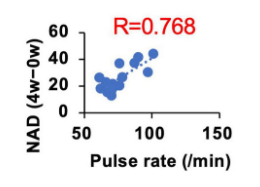
(Okabe et al., 2022 | Frontiers in Nutriton) A higher pulse rate is correlated with greater blood NAD+ levels over a four-week time course while taking 250 mg per day of NMN. Over four weeks of taking NMN, pulse rates as high as 100 beats per minute correlated with almost double the blood NAD+ levels compared to pulse rates of about 60 beats per minute. Research still does not know the exact reason or mechanism for this intriguing finding, but the possibility remains that increasing pulse rate with exercise after NMN consumption may further increase blood NAD+ levels.
Conclusive Results About NMN Will Require More Subjects and Longer Study Durations
There are several limitations to this study that necessitate further research. The current study included only 15 healthy subjects who took NMN, so future studies with more participants will be necessary to confirm the finding. While Nakagawa and colleagues show that NMN increases blood NAD+ levels, this does not necessarily mean that NAD+ levels are increased in any specific organ or tissue. Other human studies have failed to show that NMN or NR supplementation increases NAD+ levels in skeletal muscle. Therefore, future studies should also test whether administering oral NMN increases NAD+ in other organ tissues outside of the blood. In this study, the long-term effects of increasing NAD+ levels were also not tested. In order to identify any potential long-term side effects, researchers should look at human metabolic profiles following longer time courses, such as years of NMN supplementation, in healthy and non-healthy subjects.
One of the more interesting findings of this study is that higher pulse rates are correlated with increased levels of NAD+ blood availability. If true, this finding could mean that activities inducing an elevated heart rate, such as exercising, stimulate higher blood NAD+ levels.
Story Source
Okabe K, Yaku K, Uchida Y, Fukamizu Y, Sato T, Sakurai T, Tobe K, Nakagawa T. Oral Administration of Nicotinamide Mononucleotide Is Safe and Efficiently Increases Blood Nicotinamide Adenine Dinucleotide Levels in Healthy Subjects. Front Nutr. 2022 Apr 11;9:868640. doi: 10.3389/fnut.2022.868640. PMID: 35479740; PMCID: PMC9036060.
Nicotinamide mononucleotide (NMN)-treated antitumor CAR-T cells display enhanced effectiveness to combat cancer cells and reduce tumor growth in mice.
By Brett J. Weiss www.nmn.com
Highlights
Our immune system doesn’t only seek and destroy foreign substances from outside our body, it also eliminates problematic cells internally, like cancer cells and tumor growth. However, with age our immune system becomes less efficient and internal cellular errors become more probable, leading to an increased likelihood of cancer.
In an effort to give the immune system a kick, CAR-T cell therapy has been used against malignancies, especially blood cancers, which other treatments do not effectively treat. At the same time, this treatment option is limited by poor T cell survival and lack of persistent efficacy against cancer cells. Along those lines, researchers have sought new ways to improve CAR-T cell longevity and persistent capabilities to fight against cancer.
In a non-peer reviewed preprint report, Zhong and colleagues from the Capital Medical University in Beijing China demonstrate that treating CAR-T cells with 100 µM of NMN significantly improves their efficacy and persistence to attack cancer cells. Moreover, NMN treatment enhances signs of delayed cell aging, like telomere length and reduces the buildup of dead or dying CAR-T cells. What’s more, when NMN-treated CAR-T cells were injected into mice that had experimentally-induced tumors, tumor sizes significantly diminished. These findings point to a new avenue where researchers may treat CAR-T cells with NMN to improve their viability and effectiveness to fight cancer.
NMN Treatment Enhances Cancer-Fighting Abilities
To investigate the effect of NMN on human CAR-T cell proliferation and cancer-killing capacity, CAR-T cells were treated with 100 µM NMN in the presence of NALM-6 cells in culture. NALM-6 cells are a leukemia cell line that mimic the cellular conditions of blood cancer. The China-based team found that for the NMN-treated cells, a drastic 180 times more CAR-T cells were present after 28 days of culture, compared to almost all CAR-T cells dying without NMN. Moreover, in the presence of NMN, CAR-T cells maintained their ability to kill (lyse) malignant cells longer than that of non-NMN treated CAR-T cells. These results lend credulity to the notion that NMN enhances the proliferation and tumor-killing function of CAR-T cells in culture.
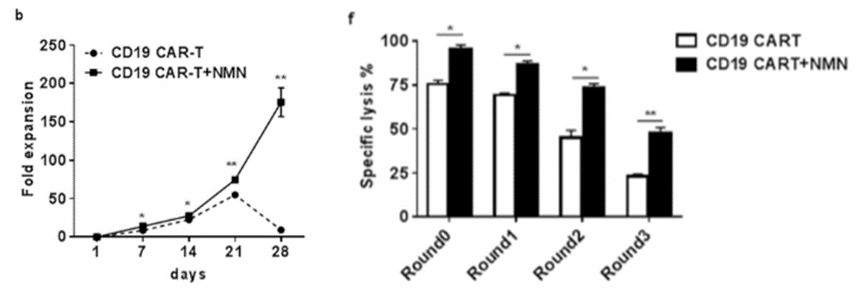
(Yu et al., 2022 | Research Square) NMN treatment dramatically enhances antitumor CAR-T cell proliferation and improves cancer attacking capabilities. Over the course of 28 days, NMN-treated CAR-T cells proliferate 180 times more than non-NMN treated CAR-T cells, which essentially die off (Figure b). CAR-T cells were treated with 100 uM of NMN four times (Round0 through Round3) over the course of 28 days. At round three (28 days), NMN-treated CAR-T cells killed (lysed) double the percentage of NALM-6 leukemia cells killed by non-NMN-treated CAR-T cells (Figure f). These findings illustrate that NMN enhances proliferation and cancer-fighting capabilities of CAR-T cells in culture.
To find whether NMN delays the aging of CAR-T cells, Zhong and colleagues tested the activity of the enzyme telomerase, which extends telomeres at the ends of chromosomes. Telomerase is a critical factor in CAR-T cell replication and overall function, and its abundance diminishes in cell division, aging, and disease.With reduced telomerase activity, CAR-T cells typically die or become aged, non-functional, and non-proliferating (senescent), leading to inhibited CAR-T function and a lack of prolonged cancer-fighting capabilities. Zhong and colleagues found that treating CAR-T cells with NMN increased telomerase activity while senescent CAR-T cell abundance substantially decreased. This finding confirms that NMN extends CAR-T cell longevity and prolongs action by promoting telomerase activity and reducing the numbers of senescent CAR-T cells in culture.
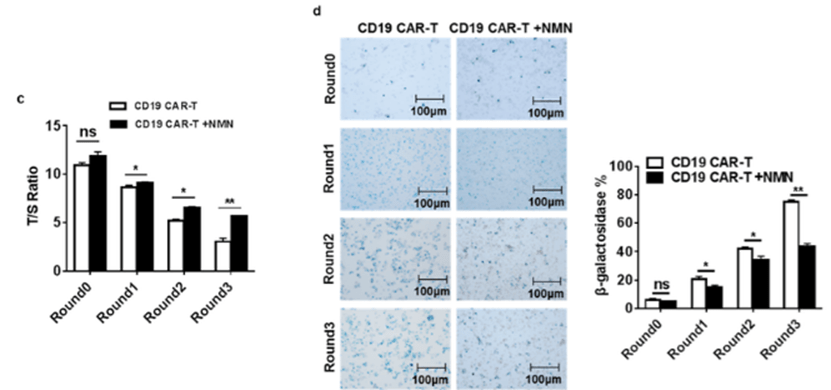
(Yu et al., 2022 | Research Square) NMN treatment significantly slows the attrition of chromosome ends (telomeres) in CAR-T cells and slows their aging. CAR-T cells were treated with 100 µM of NMN for four rounds (Round0 through Round3) over a 28-day time course, slowing down the deterioration of telomere length compared to non-treated CAR-T cells (Figure c). With NMN treatment, the numbers of senescent CAR-T cells in culture (blue dots labeled with β-galactosidase) were about half those of the non-NMN treated cells after 28 days (Figure d). These findings suggest that NMN promotes CAR-T cell longevity.
NMN-Treated CAR-T Cells Suppress Tumor Growth in Mice
Zhong and colleagues next sought to find what effects NMN-treated CAR-T cells have on tumors in mice. Mice were first injected with NALM-6 leukemia cells to generate a mouse cancer model and then injected with NMN-treated CAR-T cells. The Beijing-based team found that treatment with NMN-treated CAR-T cells promoted longer-lasting tumor suppression as shown by lower tumor volumes. These findings provide further support that NMN enhances the cancer-fighting capabilities of CAR-T cells as demonstrated in this mouse model for cancer.
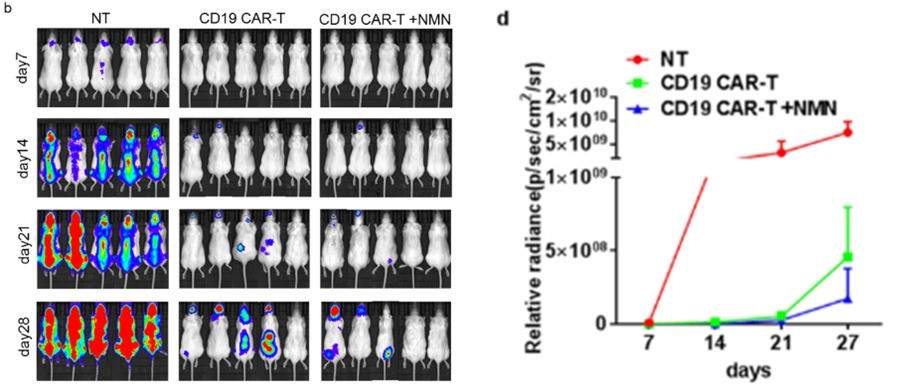
(Yu et al., 2022 | Research Square) NMN-treated CAR-T cells suppress mouse tumors. Mice were injected with human NALM-6 leukemia cells to promote tumor growth. The mice were then given no treatment (NT), CAR-T cells with no NMN (CD19 CAR-T), or NMN-treated CAR-T cells (CD19 CAR-T + NMN). After a 28-day time course, mice that received NMN-treated CD19 CAR-T cells had a lower tumor burden as shown by lower tumor radiance (figure b and d). The effects of the NMN-treated CD19 CAR-T cells were also longer lasting as illustrated by the lower tumor burden after 28 days.
NMN Stimulates the Longevity-Associated Sirt1 Gene
To find out what genes NMN stimulates, Zhong and colleagues performed gene activity analyses and found that NMN promotes the activation of the Sirt1 gene, associated with cell longevity. In NMN-treated CAR-T cells, increased Sirt1 activity was also linked with decreased activation of cell death and inflammation-associated genes. Since Sirt1 has a presumed role in suppressing the activation of cell death-associated genes, these findings provide some clues for the cell mechanism through which NMN promotes CAR-T antitumor efficacy.
Identifying Which Precise Cell Mechanisms NMN Stimulates
“In this study, we found that NMN can increase cell rejuvenation and cell proliferation by upregulating Sirt1 and provide us with great confidence NMN can enhance CD19 CAR-T cell longevity and anti-tumor efficiency,” said Zhong and colleagues in their publication.
The findings of the study highlight the potential clinical application of NMN for CAR-T cell human cancer immunotherapy. With NMN application, human CAR-T cells were more viable and had better capabilities to kill cancer cells. These findings also applied to a mouse cancer model, where injections of NMN-treated CAR-T cells reduced tumor growth, illustrating that NMN may be the key to enhance CAR-T therapy.
Future studies need to elucidate the precise cellular mechanisms by which NMN promotes CAR-T viability, longevity, and cancer-fighting abilities. A more detailed look at NMN’s effects on cells will allow researchers to pinpoint other pathways that NMN influences. In doing so, we may gain further insight into improving CAR-T cell function to fight against cancer.
This study provides insights into how NMN helps rejuvenate the immune system by jump starting CAR-T cells. Since the immune system declines with aging, it is possible that NMN could be used as a preventative measure against cancer growth.
Story Source
Zhen Yu, Shuai Tong, Can Zhang et al. Nicotinamide mononucleotide enhances the efficacy and persistence of CD19 CAR-T cells via NAD + –Sirt1 axis, 19 April 2022, PREPRINT (Version 1) available at Research Square [https://doi.org/10.21203/rs.3.rs-1483519/v1]
Treating human cells with NMN triples NAD+ levels and increases the activity of AMPK — an enzyme that turns on sugar and fat metabolism in response to low energy.
By Brett J. Weiss www.nmn.com
Highlights
Increasing nicotinamide adenine dinucleotide (NAD+) levels has promising anti-aging capabilities due to its fundamental role in cellular health. Likewise, AMPK, which is usually activated in response to low energy levels (including caloric restriction) is a fundamental molecule that promotes processes associated with longevity. Research has shown that taking the supplement nicotinamide mononucleotide (NMN) nearly doubles NAD+ in humans. Improvements in metabolic parameters like insulin sensitivity in prediabetic women and muscle oxygen utilization in long-distance runners have also been correlated with increasing NAD+ levels. Yet, dissecting a more precise cellular mechanism by which increasing NAD+ levels confer these benefits has yet to be done.
Published in the Journal of Biomedical Research and Environmental Sciences, Yamamoto and colleagues from Wellness-One Co., Ltd in Japan demonstrate that treating human MCF-7 breast cancer cells with 1 mg/mL NMN in culture raises AMP-activated protein kinase (AMPK) activity over 1,200%. What’s more, NMN treatment raised intracellular NAD+ levels three-fold. These findings suggest that by increasing NAD+ levels, NMN could boost the longevity-associated processes activated by AMPK, including enhanced mitochondrial health and autophagy — the cellular debris disposal system. This study also provides more evidence that supplementing with NAD+ precursors like NMN may drive cell energy production to alleviate faltering energy levels during aging.
NMN Boosts AMPK Activity 12-Fold and Raises NAD+ Levels
To test the effects of administering NMN on AMPK activity, Yamamoto and colleagues treated MCF-7 human breast cancer cells with 1 mg/kg in culture and measured AMPK activity. Over the course of 24 hours, the researchers found that AMPK activity increased an astounding 1230.5% after one hour, 506.5% after 12 hours, and 849.2% after 24 hours compared to cells without treatment. These findings suggest that NMN treatment has a profound effect on amplifying AMPK activity, suggesting the promotion of processes like mitochondrial production and autophagy, both shown to have anti-aging effects.
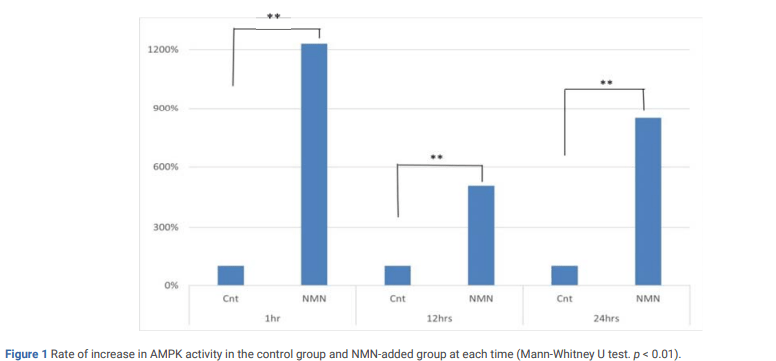
(Kawakami et al., 2022 | Journal of Biomedical Research & Environmental Sciences) NMN dramatically increases the activity of the metabolic health-promoting protein AMPK. After treating MDF-7 human breast cancer cells with 1 mg/mL NMN, AMPK activity increased over 1,200% after one hour, over 500% after 12 hours, and approximately 850% after 24 hours. These results highlight the impact of NMN treatment on increasing AMPK activity.
AMPK has recently garnered substantial attention in aging research. For example, AMPK has been found to regulate cellular energy balance, protect mitochondrial function, and facilitate a cell debris-cleaning process called autophagy. Perhaps most interestingly, by enhancing mitochondrial function, AMPK acts as a molecular energy switch for the production of the cell energy molecule adenosine triphosphate (ATP) when ATP levels fall. Faltering AMPK activity with age has been linked to reduced energy levels in older adults. Therefore, increasing AMPK activity could mitigate age-related disease and promote longevity.
Yamamoto and colleagues tested the effects of treating cancer cells with NMN on intracellular NAD+ levels. The research team found that NMN more than tripled NAD+ levels within the MCF-7 cells. These results recapitulate previous findings showing that NMN effectively boosts NAD+ levels by substantial amounts in human cells.
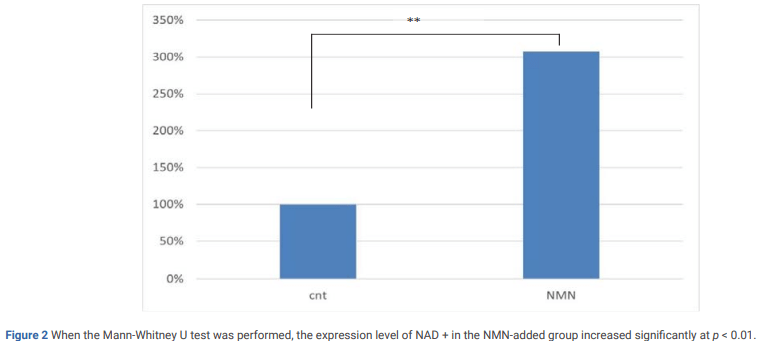
(Kawakami et al., 2022 | Journal of Biomedical Research & Environmental Sciences) NMN triples intracellular NAD+ levels in human MCF-7 breast cancer cells. Human MCF-7 breast cancer cells were treated with 1 mg/mL NMN in culture. Light absorbance was then measured to detect the presence of NAD+. Compared to non-treated cells, those that received NMN had more than triple the NAD+ concentrations within them. These results support that NMN treatment substantially increases NAD+ levels in human cells.
Does Testing Cancer Cells Recapitulate NMN’s Effects on Healthy Cells?
By enhancing the activity of the cell energy-regulating AMPK, NMN may promote cellular rejuvenation as breast cancer cells age. Possibly the biggest issue with the study, though, was that Yamamoto and colleagues used the MCF-7 breast cancer cell lineage that may have already had low AMPK activation and faltering NAD+ levels. There are numerous alternative cell lines that do not come from diseased tissues like breast cancer that Yamamoto and colleagues could have used, such as vascular cells (endothelial cells). The use of the breast cancer cells may be seen as a major limitation of the study since little is known about how diseased tissue like cancer affects AMPK activity and NAD+ levels.
Analyzing NMN’s Impact on Blood ATP Levels in HumansFuture studies examining the efficacy of NMN against aging could look at blood plasma ATP levels to find out whether taking NMN boosts cell energy. The recommended dose of NMN lies somewhere between 250 mg to 500 mg per day, so a dose-dependency analysis could test the effects of different daily doses of NMN. This experiment could span over the course of a few months to find out whether NMN not only potentially boosts AMPK activity and NAD+ levels but also results in higher ATP production.
Story Source
Kawakami S, Fukuzawa Y, Ichikawa H, Sato T, Ide T, Maeda Y, Yamamoto T. NMN “Nicotinamide Mononucleotide” Activates Intracellular Energy and Approaches the Prevention and Improvement of Aging. J Biomed Res Environ Sci. 2022 May 21; 3(5): 560-565. doi: 10.37871/jbres1480, Article ID: JBRES1480, Available at: https://www.jelsciences.com/ articles/jbres1480.pdf